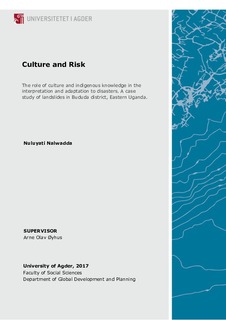| dc.description.abstract | This study explores the role culture and indigenous knowledge play in people’s ‘interpretation’ and ‘adaption’ to landslides in Uganda. This study is important because globally, natural hazards are becoming more dangerous and destructive than ever before, causing an increasing number of disasters that interfere with a community’s livelihood and set back development efforts. Decades of Disaster Risk Reduction (DRR) strategies notwithstanding, many people are still vulnerable to disasters. It can be argued however, that people are still vulnerable because aspects of their culture and indigenous knowledge have been missing in these strategies. Organisations involved in DRR often assume that with essential information, people would not ‘live’ in ‘risky’ areas, which is not always the case. Culture and indigenous knowledge are important sources of social capital that can be utilised for disaster preparedness, response, recovery and adaptation. Thus, they should be at the centre of the strategies intending to address the problem. From the study, culture and indigenous knowledge influenced the way people interpreted the cause of landslides and ultimately, how responded and adapted to them. Survivors made decisions concerning relocation based on their cultural beliefs and past experiences. Nonetheless, the government and NGOs involved in landslide risk reduction have ignored the important role of people’s culture and indigenous knowledge. The study identified the missing piece of the jigsaw from the activities of these organisations, which is to endeavour, understand and incorporate culture and indigenous knowledge of local people who live in disaster prone areas. This is because, through their exposure to past landslides, people have developed a body of knowledge and beliefs that they use to interpret and ‘live’ with the risks from landslides. This knowledge can be tapped and integrated for sustainable disaster risk reduction. External organisations do not necessarily need to ‘believe’ in what local people ‘believe in’, but they should understand, accept and ‘work with’ the fact that those affected by disasters have considerations and priorities based on their culture and experiences that are likely to impact on disaster management strategies and development | nb_NO |

